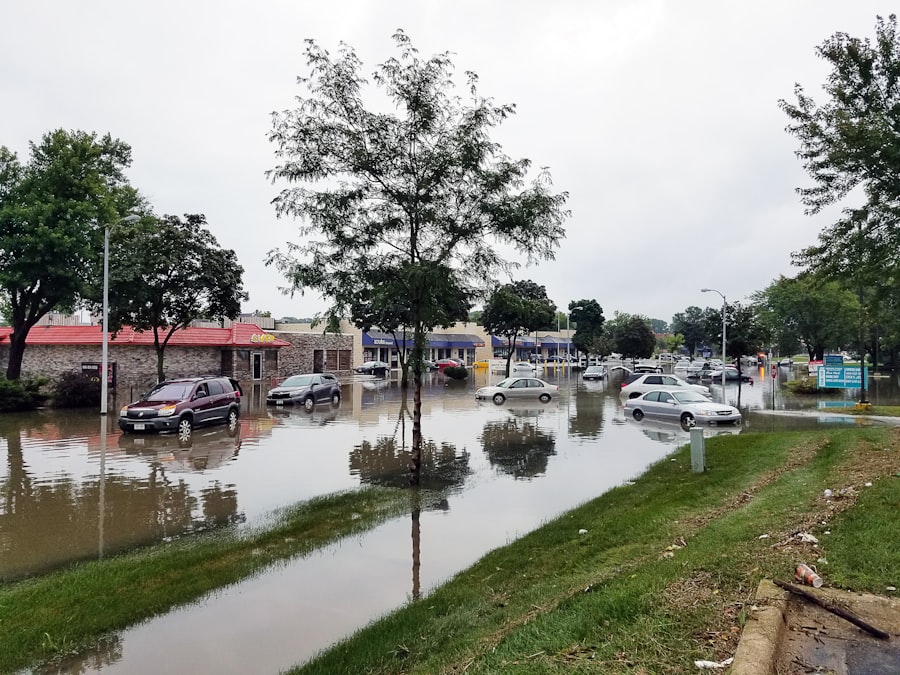Flood risk assessment plays a crucial role in safeguarding communities and infrastructure from the devastating impacts of flooding. By systematically evaluating the potential for flooding in a given area, stakeholders can identify vulnerable regions and prioritize resources for mitigation efforts. This proactive approach not only helps in minimizing economic losses but also protects lives and enhances the resilience of communities.
Flood risk assessments provide essential data that inform urban planning, emergency response strategies, and insurance underwriting, making them indispensable tools for governments, businesses, and residents alike. Moreover, the importance of flood risk assessment extends beyond immediate disaster preparedness. It fosters a culture of awareness and education regarding flood risks among community members.
When individuals understand the potential hazards associated with flooding, they are more likely to take personal responsibility for their safety and that of their families. This heightened awareness can lead to increased participation in local planning initiatives and support for policies aimed at reducing flood risk. Ultimately, effective flood risk assessment serves as a foundation for sustainable development, ensuring that communities can thrive even in the face of natural disasters.
Factors Contributing to Flood Risk
Several factors contribute to the overall risk of flooding in any given area, each interplaying with one another to create a complex web of vulnerabilities. Geographic features such as topography, soil type, and proximity to water bodies significantly influence flood risk. For instance, low-lying areas are inherently more susceptible to flooding, especially during heavy rainfall or storm surges.
Additionally, the type of soil can affect how quickly water is absorbed; clay soils tend to retain water longer than sandy soils, leading to increased surface runoff and potential flooding. Human activities also play a pivotal role in exacerbating flood risk. Urbanization, for example, often leads to the replacement of permeable surfaces with impermeable ones, such as concrete and asphalt.
This change reduces the land’s natural ability to absorb rainfall, resulting in higher volumes of runoff that can overwhelm drainage systems. Deforestation and land-use changes further compound these issues by disrupting natural water flow patterns. As communities expand and develop without adequate planning for flood management, the risk of flooding increases significantly, highlighting the need for comprehensive assessments that consider both natural and anthropogenic factors.
Methods of Assessing Flood Risk

Assessing flood risk involves a variety of methodologies that combine scientific research with practical applications. One common approach is hydrological modeling, which simulates how water moves through a landscape under different conditions. By analyzing historical rainfall data, river flow rates, and land use patterns, hydrologists can predict how various scenarios might impact flood levels in specific areas.
This quantitative analysis is essential for understanding potential flood events and informing decision-making processes. In addition to hydrological modeling, geographic information systems (GIS) have become invaluable tools in flood risk assessment. GIS technology allows for the visualization and analysis of spatial data related to topography, land use, and infrastructure.
By layering different datasets, planners can identify high-risk zones and assess the potential impact of flooding on critical assets such as roads, bridges, and utilities. Furthermore, community input is increasingly being integrated into these assessments through participatory mapping exercises, where residents contribute local knowledge about historical flooding events and vulnerable areas. This combination of technical analysis and community engagement enhances the accuracy and relevance of flood risk assessments.
The Role of Climate Change in Flood Risk
| Location | Year | Number of Floods | Severity |
|---|---|---|---|
| United States | 2020 | 100 | High |
| India | 2019 | 75 | Medium |
| China | 2018 | 120 | High |
Climate change has emerged as a significant factor influencing flood risk across the globe. As global temperatures rise, so do the frequency and intensity of extreme weather events, including heavy rainfall and storms. These changes can lead to more severe flooding in regions that may have previously experienced only minor inundation.
For instance, coastal areas are particularly vulnerable to rising sea levels and increased storm surges, which can inundate low-lying communities and disrupt ecosystems. Moreover, climate change affects precipitation patterns, leading to unpredictable weather conditions that complicate flood forecasting efforts. Areas that once enjoyed predictable seasonal rainfall may now experience sudden deluges or prolonged droughts, making it challenging for communities to prepare adequately for potential flooding.
As such, integrating climate change projections into flood risk assessments is essential for developing effective mitigation strategies. By understanding how climate change will impact local weather patterns and hydrology, communities can better prepare for future flooding scenarios.
Understanding the Impact of Urbanization on Flood Risk
Urbanization significantly alters the natural landscape and can dramatically increase flood risk in metropolitan areas. As cities expand, natural drainage systems are often disrupted or replaced with artificial ones that may not be equipped to handle extreme weather events. The proliferation of impervious surfaces—such as roads, parking lots, and buildings—reduces the land’s ability to absorb rainfall, leading to increased surface runoff that can overwhelm drainage systems.
Additionally, urbanization often leads to the encroachment on wetlands and floodplains that serve as natural buffers against flooding. These ecosystems play a vital role in absorbing excess water during heavy rains; their destruction exacerbates flood risks in surrounding areas. Furthermore, urban heat islands created by dense development can lead to localized weather changes that may increase rainfall intensity in certain regions.
Understanding these dynamics is crucial for urban planners and policymakers as they work to create resilient cities capable of withstanding future flooding challenges.
The Importance of Community Engagement in Flood Risk Assessment

The Importance of Local Insight
Involving local residents in the flood risk assessment process is crucial for collecting high-quality data and fostering a sense of ownership over flood mitigation efforts. Residents possess valuable knowledge about their neighborhoods’ historical flooding patterns and vulnerabilities that may not be captured through traditional data collection methods.
Enhancing Awareness and Preparedness
By incorporating local insight into assessments, planners can develop more accurate models and targeted strategies. Moreover, engaging communities in discussions about flood risk promotes awareness and preparedness among residents. When individuals understand their vulnerability to flooding and the measures they can take to protect themselves, they are more likely to participate in resilience-building initiatives.
Empowering Communities for Sustainable Solutions
Community workshops, public meetings, and educational campaigns can empower residents to advocate for necessary changes in local policies or infrastructure improvements. Ultimately, fostering strong community ties around flood risk assessment leads to more effective and sustainable solutions.
Mitigation Strategies for Reducing Flood Risk
Mitigation strategies are essential for reducing flood risk and enhancing community resilience. These strategies can be broadly categorized into structural and non-structural measures. Structural measures include the construction of levees, dams, and floodwalls designed to control water flow and protect vulnerable areas from inundation.
While these solutions can be effective in managing floodwaters during extreme events, they often require significant investment and ongoing maintenance. Non-structural measures focus on policy changes and community engagement initiatives aimed at reducing vulnerability to flooding. Zoning regulations that limit development in high-risk areas can help preserve natural floodplains and wetlands while promoting sustainable land use practices.
Additionally, implementing early warning systems and emergency response plans ensures that communities are prepared for potential flooding events. Public education campaigns that inform residents about flood risks and preparedness measures further enhance community resilience by equipping individuals with the knowledge they need to respond effectively during emergencies.
The Future of Flood Risk Assessment and Management
The future of flood risk assessment and management is poised for transformation as advancements in technology and data analytics continue to evolve. The integration of artificial intelligence (AI) and machine learning into flood modeling holds great promise for improving predictive capabilities. These technologies can analyze vast amounts of data from various sources—such as satellite imagery, weather forecasts, and historical records—to generate more accurate predictions about potential flooding events.
Furthermore, there is a growing recognition of the importance of holistic approaches that consider social equity in flood risk management. As communities become increasingly diverse, it is essential to ensure that all residents have access to information about flood risks and resources for preparedness. Future assessments will likely prioritize inclusivity by engaging marginalized populations who may be disproportionately affected by flooding.
In conclusion, as climate change continues to reshape our environment and urbanization accelerates across the globe, the need for comprehensive flood risk assessment becomes ever more critical. By understanding the multifaceted nature of flood risks—ranging from environmental factors to human activities—communities can develop effective strategies for mitigation and resilience-building. Through collaboration between stakeholders at all levels—government agencies, scientists, community members—the future holds promise for more robust flood risk management practices that protect lives and livelihoods from the impacts of flooding.
When conducting a flood risk assessment, it is important to consider all potential natural disasters that could impact an area. One such disaster to consider is tornadoes, which can cause significant damage and increase the risk of flooding. For more information on tornadoes, including which state has the most tornadoes, what a multi-vortex tornado is, and how fast tornadoes spin, check out the related articles on Tornado Extreme. Understanding the various natural disasters that can occur in a region is crucial for accurately assessing flood risk and implementing effective mitigation strategies.

